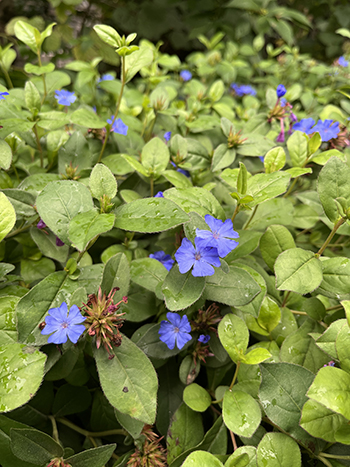
Plants of the Week: August 5
Guest Author: Annarose Klinger, 2024 Summer Intern

Thalictrum delavayi (meadow rue)
Along the path of the Terry Shane Teaching Garden, Thalictrum delavayi is in bloom. This herbaceous perennial hails from East Asia and is hardy in zones 4-7. Meadow rue is clump forming and can grow from 3 to 5 feet tall with up to a 2-foot spread. It will grow in part sun and average soils. Watering is needed during particularly dry seasons.
Meadow rue has purple petals with numerous prominent yellow stamens. The flowers are small and held in airy panicles above pinnately compound foliage. The foliage of Thalictrum delavayi has a delicate look and can resemble the fronds of a maidenhair fern. This plant is great for adding a little color and airy texture to a garden without adding heaviness. Meadow rue is also considered deer resistant. This may be a great choice for a shaded spot in your garden!

Ceratostigma plumbaginoides (plumbago)
This week, a swath of plumbago along the sidewalk outside of McCabe Library really stood out. Ceratostigma plumbaginoides is an herbaceous, low-growing perennial native to China. It is hardy in USDA zones 5-9 and can tolerate both moist and occasionally dry conditions. Plumbago has bright green leaves that turn red in fall as well as blue star-shaped flowers. The flowers of plumbago bloom from summer to fall.
Ceratostigma plumbaginoides is a great choice for a living mulch. Living mulches can help suppress weeds and ease soil erosion in some areas. The low-growing plumbago spreads via rhizome and can become quite aggressive, although it is not considered invasive. It’s a great choice for places such as hillsides, weed prone areas, and along borders. Plumbago’s maintenance needs depend on the style and area of the garden it is planted in. In smaller or more formal areas, thinning will be required to prevent too much spread. In larger and less formal designs, plumbago is a great choice to let crawl wherever it may please.

Lycoris chinensis (golden surprise lily)
Lycoris is a fan favorite in late summer and it’s clear why! In Clothier Circle, the golden yellow blooms of Lycoris chinensis stand out against the green foliage of the area. Hardy in USDA zones 5-9, the surprise lily is a great way to add pops of color in late summer. Lycoris chinensis has a medium height and spread of about 2 feet by 2 feet and needs average water with full sun or part shade.
Lycoris chinensis is a bulb that will show foliage in spring that will eventually die back before its flowers emerge in late summer on lone, upright stalks. L. chinensis has unique wavy golden petals and prominent golden stamens. The genus Lycoris takes its name from a mistress of Mark Antony known for her beauty.





No Comments